Looking for a delicious Arabic spinach pie that’ll transport your taste buds to the Middle East? This traditional fatayer bi sabanekh is the perfect blend of flaky dough and savory spinach filling that you’ll want to make again and again.
Arabic spinach pie, also known as fatayer, has been a staple in Middle Eastern cuisine for generations. The triangle-shaped pastries feature a tender dough wrapped around a filling of vibrant spinach, tangy sumac, and aromatic spices. They’re perfect as appetizers, party snacks, or packed lunches.
What Is Arabic Spinach Pie?
Arabic spinach pie or “fatayer bi sabanekh” is a beloved Middle Eastern pastry featuring a tender dough wrapped around a flavorful spinach filling. These triangle-shaped delicacies showcase the perfect balance between a light crispy exterior and a savory interior bursting with aromatic spices.
The dough traditionally consists of flour olive oil and yogurt creating a distinctly Mediterranean texture that’s both pillowy and slightly chewy when baked. Each triangular pocket contains a vibrant green filling made from fresh spinach mixed with onions sumac lemon juice and olive oil.
What sets authentic Arabic spinach pies apart is the careful blend of spices and tart ingredients. Sumac provides a distinctive tangy flavor while pomegranate molasses adds subtle sweetness in some regional variations. Pine nuts or walnuts often introduce a pleasant textural contrast to the tender filling.
These handheld pastries serve multiple purposes in Arabic cuisine. They function as everyday snacks casual mezze offerings or components of elaborate feast spreads. Throughout Lebanon Syria Palestine Jordan and beyond each region maintains slight variations in preparation techniques and seasoning preferences while preserving the dish’s essential character.
Unlike Greek spanakopita which uses phyllo dough Arabic spinach pies feature a yeasted dough that’s rolled thicker creating a more substantial pastry. The distinctive triangular folding technique not only creates an attractive presentation but also securely contains the filling during baking.
Whether enjoyed warm from the oven or at room temperature these versatile pastries maintain their flavor profile making them perfect for meal prep advance party preparation or packed lunches.
Why You’ll Love This Arabic Spinach Pie
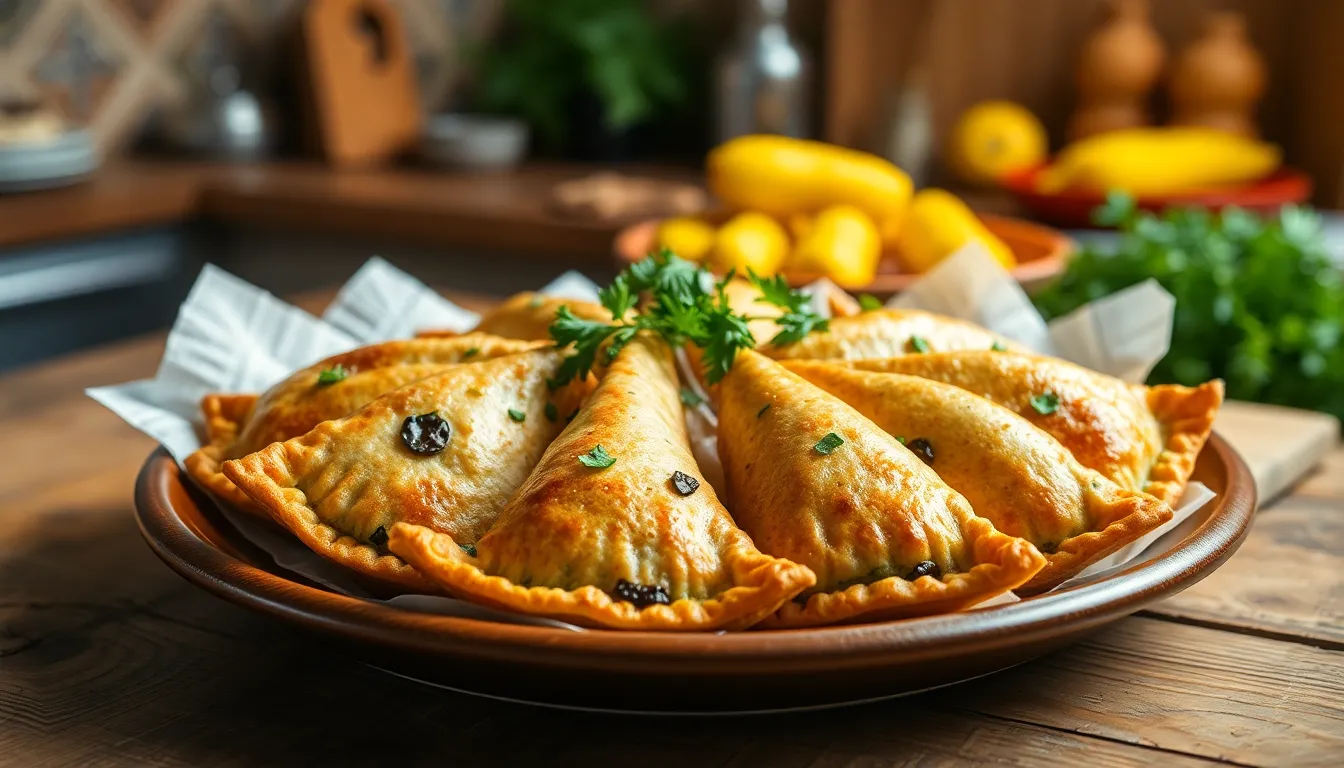
These homemade spinach fatayer will quickly become a favorite in your recipe collection for several compelling reasons:
- Perfect balance of flavors – The combination of fresh spinach with tangy sumac and bright lemon juice creates a distinctive taste that’s both bold and comforting.
- Versatile serving options – Enjoy these pies warm from the oven or at room temperature making them ideal for meal prep lunches parties or quick snacks.
- Impressive presentation – The triangular shape makes these pies visually striking on any serving platter impressing guests without requiring advanced culinary skills.
- Nutritious ingredients – Packed with iron-rich spinach these pies offer a delicious way to incorporate more greens into your diet.
- Make-ahead friendly – The dough and filling can be prepared in advance or you can freeze fully baked pies for convenient future meals.
- Customizable filling – While traditional recipes shine on their own you can easily adjust the spinach mixture to your taste preferences by adding pine nuts feta cheese or pomegranate molasses.
- Satisfying texture contrast – The pillowy yet slightly chewy dough perfectly complements the tender savory filling creating a satisfying bite every time.
- Budget-friendly option – Using simple pantry staples and seasonal spinach these pies deliver impressive flavor without expensive ingredients.
- Heritage recipe with modern appeal – This traditional Middle Eastern favorite carries centuries of culinary history yet fits perfectly into contemporary meal plans.
Ingredients For Arabic Spinach Pie

Creating authentic Arabic spinach pies requires simple pantry staples combined with fresh produce. Each component plays an essential role in achieving the perfect balance of flavors and textures that make fatayer bi sabanekh so beloved.
For The Dough
- 3 cups all-purpose flour
- 1 tablespoon active dry yeast
- 1 teaspoon sugar
- 1 teaspoon salt
- ¼ cup olive oil
- ¼ cup plain yogurt
- ¾ to 1 cup warm water (temperature around 110°F)
- 1 tablespoon milk for brushing (optional)
For The Spinach Filling
- 2 pounds fresh spinach, washed and finely chopped (or 20 oz frozen spinach, thawed and drained)
- 1 medium onion, finely diced
- 3 tablespoons olive oil
- ¼ cup lemon juice, freshly squeezed
- 2 tablespoons sumac
- 1 teaspoon salt
- ½ teaspoon black pepper
- ¼ cup pine nuts (optional)
- 2 tablespoons pomegranate molasses (optional)
- 1 teaspoon cumin (optional)
Equipment Needed
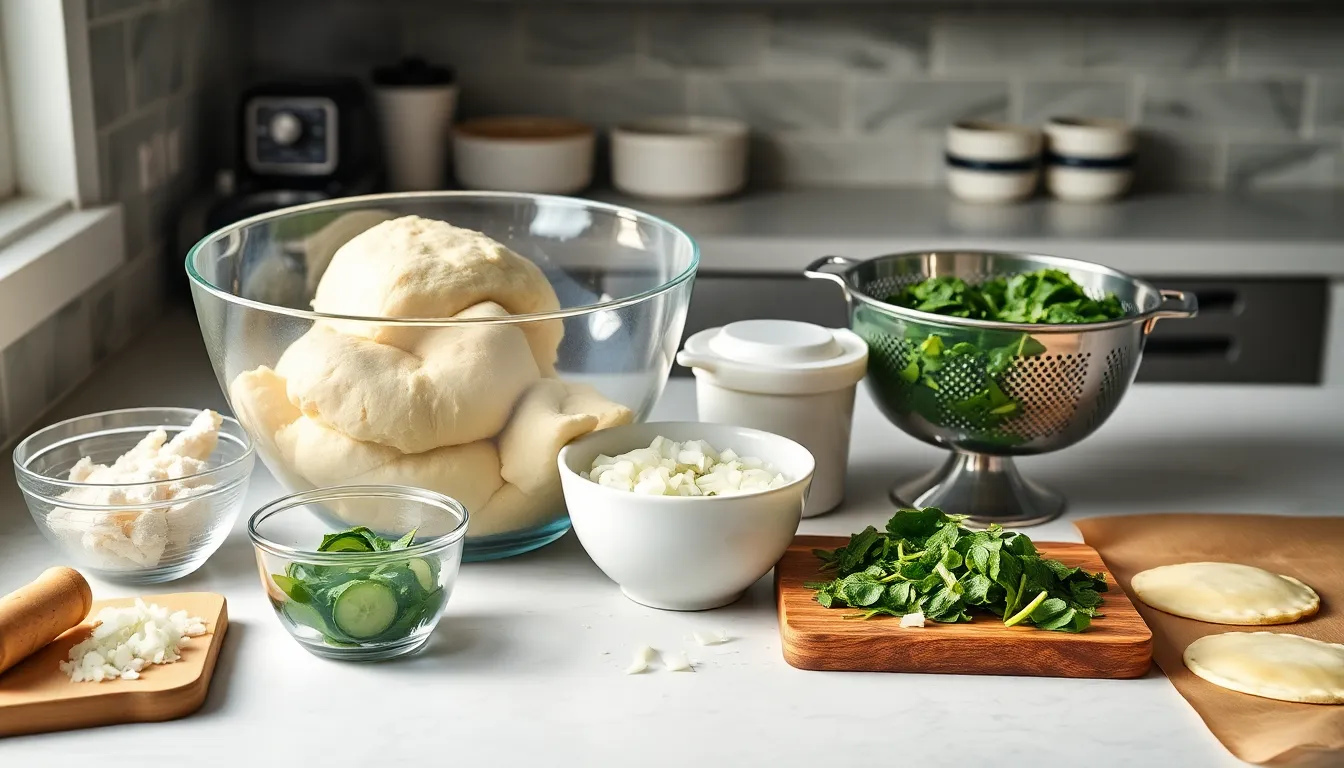
Preparing Arabic spinach pies requires just a few basic kitchen tools that most home cooks already have on hand. Gather these items before starting your fatayer bi sabanekh:
- Large mixing bowl – For preparing and kneading the dough
- Medium bowl – For mixing the spinach filling
- Measuring cups and spoons – For accurate ingredient measurements
- Cutting board and knife – For chopping onions and preparing spinach
- Colander – Essential for draining excess moisture from spinach
- Baking sheets – You’ll need 2-3 standard-sized trays depending on batch size
- Parchment paper – For lining baking sheets to prevent sticking
- Rolling pin – To roll the dough to proper thickness
- Pastry brush – For applying milk or egg wash before baking
- Spatula – For mixing ingredients and transferring pies
- Clean kitchen towel – For covering dough while it rises
- Cookie cutter or glass – Approximately 4 inches in diameter for cutting dough circles
No specialized equipment is necessary for these traditional pastries. The simple tools reflect the authentic nature of this Middle Eastern classic that has been prepared in home kitchens for generations. Having everything organized before you begin will streamline the process of forming and baking your triangular spinach pies.
How To Make Arabic Spinach Pie

Creating authentic Arabic spinach pies requires attention to detail in each step of the process. Follow these instructions to master this beloved Middle Eastern classic right in your own kitchen.
Preparing The Dough
Start by combining 3 cups of all-purpose flour and 1 teaspoon of salt in a large mixing bowl. Create a well in the center and pour in ¼ cup of olive oil. Add 1 cup of plain yogurt to the mixture and stir until the ingredients begin to come together. Knead the dough on a floured surface for about 5-7 minutes until it becomes smooth and elastic. Form the dough into a ball and coat it lightly with olive oil. Place the dough in a clean bowl covered with a damp kitchen towel and let it rest for at least 30 minutes at room temperature. This resting period allows the gluten to relax, making the dough easier to roll out later. The dough should double in size and feel soft and pliable when properly rested.
Making The Spinach Filling
Wash 1 pound of fresh spinach thoroughly and drain in a colander. Squeeze out any excess moisture and chop the spinach into small pieces. Heat 2 tablespoons of olive oil in a large pan and sauté 1 finely diced onion until translucent. Add the chopped spinach to the pan and cook just until wilted, about 2-3 minutes. Transfer the mixture to a bowl and let it cool completely. Once cooled, add 2 tablespoons of sumac, the juice of 1 lemon, 2 tablespoons of olive oil, and salt and pepper to taste. Mix well to ensure the flavors are evenly distributed throughout the filling. Optional additions include ¼ cup of toasted pine nuts or 2 tablespoons of pomegranate molasses for enhanced flavor complexity.
Assembling The Pies
Preheat your oven to 400°F (200°C) and line two baking sheets with parchment paper. Divide the rested dough into equal portions, about the size of golf balls. On a lightly floured surface, roll each portion into a circle approximately 4-5 inches in diameter and about ⅛ inch thick. Place a heaping tablespoon of spinach filling in the center of each circle. Fold the dough to create a triangle by bringing up three sides of the circle to meet in the center, pinching the seams firmly to seal. Ensure there are no openings that might allow the filling to leak during baking. Place the assembled pies on the prepared baking sheets, leaving about an inch of space between each one.
Baking The Spinach Pies
Brush the tops of the assembled pies with olive oil to promote browning and add a subtle sheen. Bake in the preheated oven for 15-18 minutes or until the pies are golden brown. Rotate the baking sheets halfway through cooking to ensure even browning. The pies should feel firm to the touch when done, with a slightly crisp exterior and tender interior. Remove from the oven and let them cool on the baking sheets for 5 minutes before transferring to a wire rack. These spinach pies can be served warm or at room temperature and pair wonderfully with a side of yogurt or a simple green salad. Leftover pies can be stored in an airtight container in the refrigerator for up to 3 days or frozen for longer storage.
Tips For Perfect Arabic Spinach Pie

Drain Your Spinach Thoroughly
Remove all excess moisture from your spinach before adding it to the filling. Squeeze fresh spinach vigorously after washing or drain frozen spinach completely. Excess water will make your dough soggy and can cause leaks during baking.
Perfect Your Dough Consistency
Achieve the ideal dough texture by adding liquid gradually. The dough should feel soft and pliable but not sticky. If it becomes too dry add a tablespoon of water at a time. For dough that’s too sticky incorporate small amounts of flour until manageable.
Master the Triangle Fold
Create secure triangular shapes by placing filling in the center of each dough circle without overfilling. Pinch two sides together first then bring the third side up to form a triangle. Press seams firmly between your fingers and twist slightly at each corner for a tight seal.
Balance Your Flavors
Adjust seasonings to create the perfect flavor profile. Sumac provides essential tanginess while lemon juice brightens the filling. Taste your spinach mixture before assembling and add more salt olive oil or acidity as needed.
Rest Your Dough Properly
Allow dough to rest at least 30 minutes before rolling. This relaxes the gluten resulting in a more tender pastry that’s easier to shape. For best results cover with a damp cloth during resting to prevent drying.
Roll Dough to the Right Thickness
Maintain consistent thickness when rolling your dough circles approximately 1/8-inch thick. Too thin and they’ll tear during folding too thick and they’ll become doughy when baked. Use a ruler to measure until you develop a feel for the proper thickness.
Bake at the Proper Temperature
Preheat your oven thoroughly to 400°F (200°C) before baking. This initial high heat helps set the dough structure. For extra browning brush pies lightly with olive oil before placing them in the oven.
Prevent Soggy Bottoms
Place fatayer on a preheated baking sheet or use parchment paper to absorb excess moisture. Bake on the middle or lower rack of your oven to ensure the bottom crust cooks properly.
Allow for Proper Cooling
Let your spinach pies cool for 5-10 minutes after baking. This allows the filling to set and prevents burning your mouth. The pies will maintain their shape better when slightly cooled.
Troubleshooting Common Issues
If your fatayer open during baking you likely overfilled them or didn’t seal properly. For leaking filling squeeze spinach more thoroughly next time. Dough that’s difficult to work with typically needs more resting time or slight moisture adjustments.
Variations To Try

While traditional Arabic spinach pies are delicious in their classic form, several regional and modern variations can add exciting new dimensions to this beloved dish. Experiment with these alternatives to discover your favorite version.
Add Cheese
Transform your fatayer by incorporating cheese into the filling. Crumbled feta adds a tangy saltiness that complements the earthy spinach perfectly. You might also try akkawi cheese for an authentic Middle Eastern touch or mozzarella for a milder option. Simply sprinkle 1/4 cup of your preferred cheese into the spinach mixture before filling the dough triangles.
Include Meat
For a more substantial version, add ground lamb or beef to your spinach filling. Brown 1/2 pound of ground meat with the onions before combining with spinach. Season with additional allspice and cinnamon for a rich flavor profile typical in Lebanese variations. This protein-packed version makes a satisfying main course rather than just an appetizer.
Try Different Greens
Substitute other leafy greens for all or part of the spinach. Swiss chard offers a slightly sweeter profile while maintaining the tender texture. Kale provides a heartier bite and earthier flavor but requires slightly longer cooking time. A mix of spinach and purslane creates a lemony undertone popular in Palestinian versions of this dish.
Incorporate Nuts and Dried Fruits
Pine nuts are a traditional addition that brings wonderful texture and nutty flavor. Toast 1/4 cup before adding to your filling. Walnuts work beautifully too. For a Syrian-inspired variation, incorporate 2 tablespoons of pomegranate arils or 1 tablespoon of currants to introduce subtle sweetness that balances the savory elements.
Spice Variations
Adjust the spice profile to create regional differences. Lebanese versions often feature more sumac and lemon, while Palestinian variations might include more allspice. Add 1/2 teaspoon of za’atar for a more herbaceous profile or a pinch of Aleppo pepper for gentle heat. Some families include fresh herbs like dill or mint for brightness.
Dough Alternatives
While the traditional yogurt dough is ideal, you can experiment with different bases. Some bakers use a butter-based pastry for extra flakiness. Others incorporate whole wheat flour for a nuttier flavor and additional fiber. For a quick version, quality store-bought pizza dough can serve as a time-saving alternative while still delivering satisfying results.
Shape Variations
Beyond the classic triangle shape, try forming your spinach pies into different configurations. Small rounds with pinched tops create boat-shaped fatayer that show off the filling. Larger, open-faced versions similar to manakish allow the spinach to develop appealing crispy edges during baking. Each shape affects the ratio of dough to filling, creating different eating experiences.
Serving Suggestions
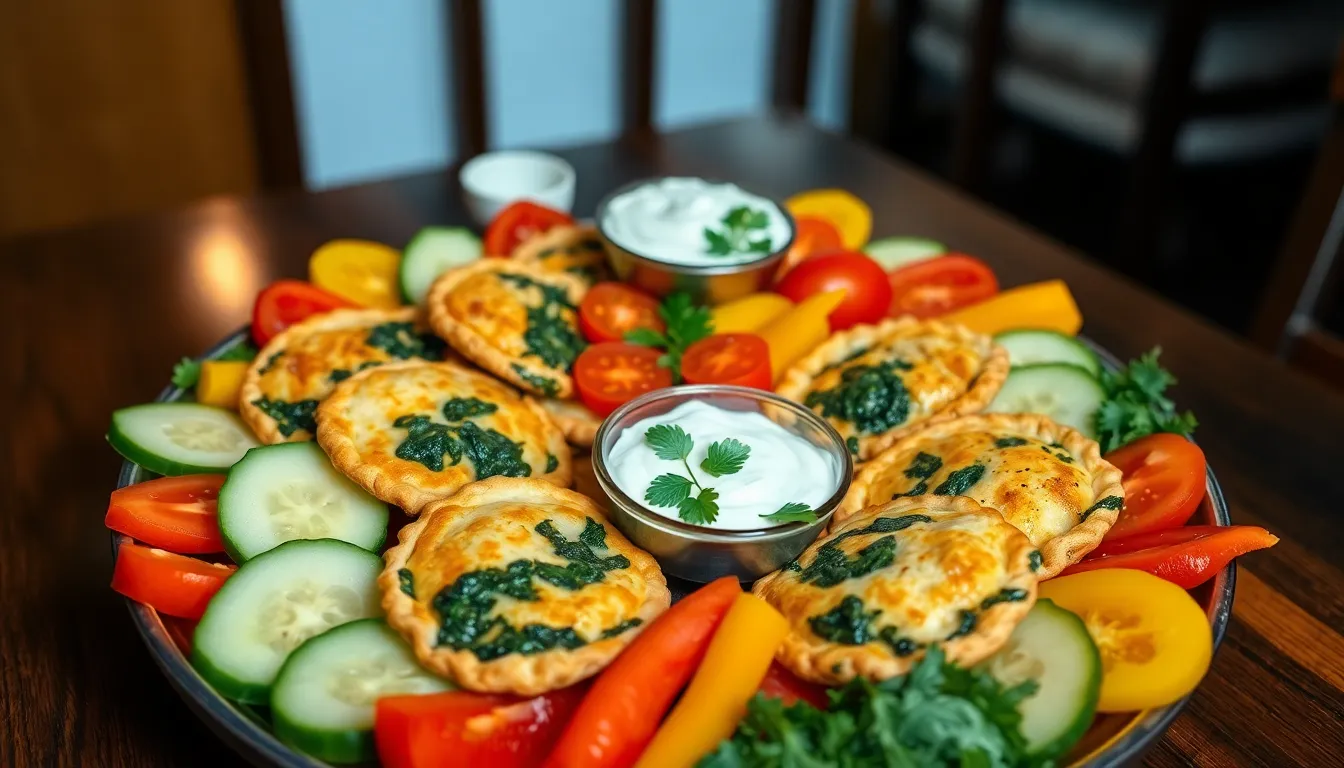
Arabic spinach pies shine brightest when paired with complementary dishes and beverages that enhance their flavor profile. Serve these triangular pastries alongside a bowl of creamy yogurt dip or labneh for a cooling contrast to the savory spinach filling. Fresh vegetable platters featuring cucumber slices tomatoes and bell peppers provide a crisp textural balance to the tender fatayer.
For a complete mezze spread arrange your spinach pies on a large platter with other Middle Eastern favorites such as hummus baba ghanoush and tabbouleh salad. This creates an impressive appetizer selection perfect for entertaining guests or family gatherings. Stuffed grape leaves (dolmas) and falafel also pair wonderfully with these spinach treats.
Transform your spinach fatayer into a satisfying meal by serving them with a hearty lentil soup or a bright Mediterranean salad dressed with olive oil and lemon juice. The acidity from the salad cuts through the richness of the pies while adding freshness to each bite.
Beverage pairings matter significantly when serving Arabic spinach pies. Traditional options include mint tea black tea with fresh mint leaves or Turkish coffee for an authentic Middle Eastern experience. For a refreshing alternative try serving with ayran (a yogurt drink) or a glass of pomegranate juice that complements the sumac in the filling.
Consider temperature when serving your fatayer. These versatile pies taste excellent warm from the oven room temperature in a packed lunch or even cold from the refrigerator the next day. Their flavor actually develops overnight making them ideal for preparing ahead for gatherings.
Presentation elevates the dining experience substantially. Arrange your triangular pies in a circular pattern on a decorative plate garnished with fresh herbs like parsley or mint. Sprinkle sumac or za’atar around the plate edges for both visual appeal and an extra flavor boost when desired.
Storing And Reheating
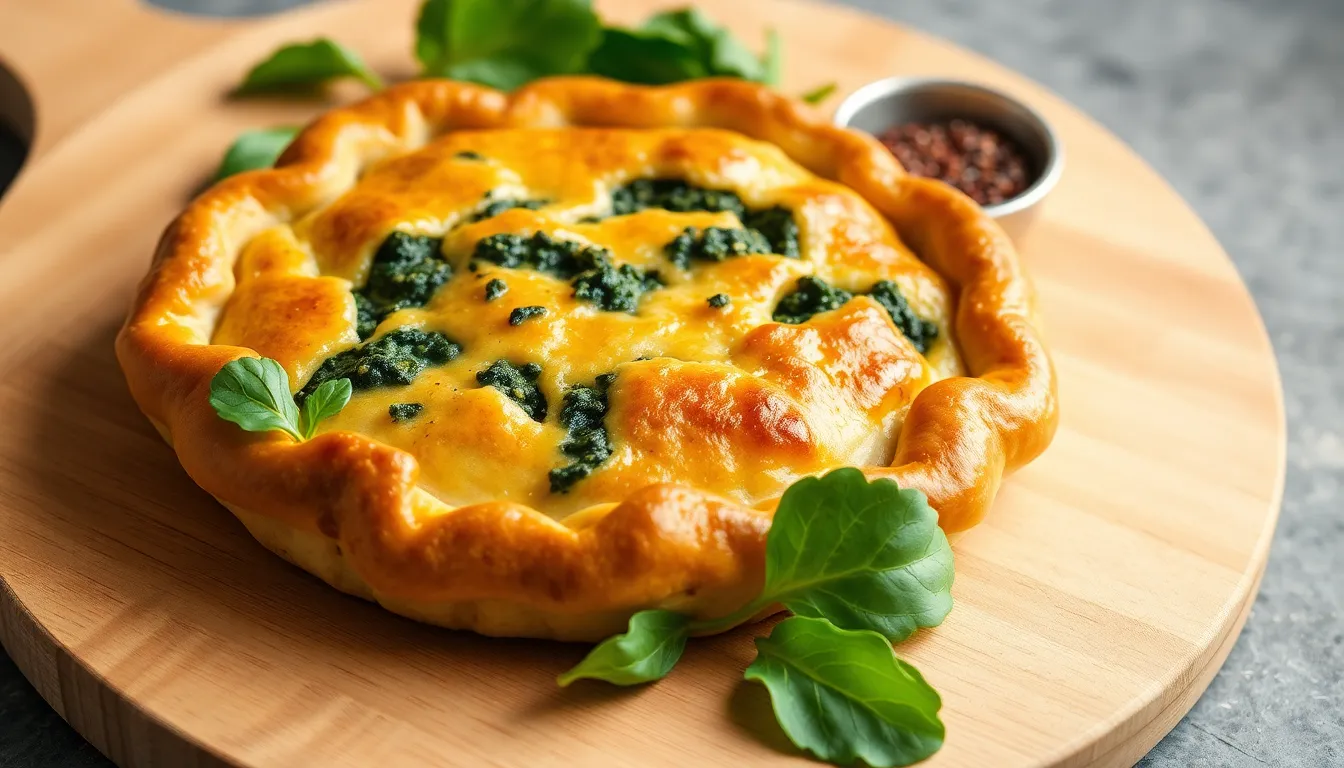
Arabic spinach pies maintain their delicious flavor and texture when properly stored. To keep your fatayer fresh after baking allow them to cool completely on a wire rack before storage. Place them in an airtight container lined with paper towels to absorb any excess moisture and refrigerate for up to 3 days.
For longer storage freeze your cooled spinach pies in a single layer on a baking sheet until solid. Transfer the frozen pies to a freezer-safe container or ziplock bag with parchment paper between layers to prevent sticking. Properly frozen fatayer will maintain quality for up to 3 months making them perfect for meal prep.
When you’re ready to enjoy your stored spinach pies reheating them properly ensures they retain their delightful texture. For refrigerated pies place them on a baking sheet and warm in a 350°F (175°C) oven for 7-10 minutes until heated through. This method helps restore the crispness of the dough better than microwave reheating.
Frozen spinach pies can be reheated directly from frozen—no need to thaw first. Simply place them on a baking sheet and bake at 350°F (175°C) for 15-20 minutes until thoroughly heated. For a quick option microwave individual pies for 1-2 minutes though the texture may become slightly softer than oven reheating.
The flavor of Arabic spinach pies often develops overnight making day-old pies particularly delicious. Some Middle Eastern families intentionally make extra fatayer specifically to enjoy the next day when the sumac and lemon notes have fully permeated the filling.
Make Ahead Instructions
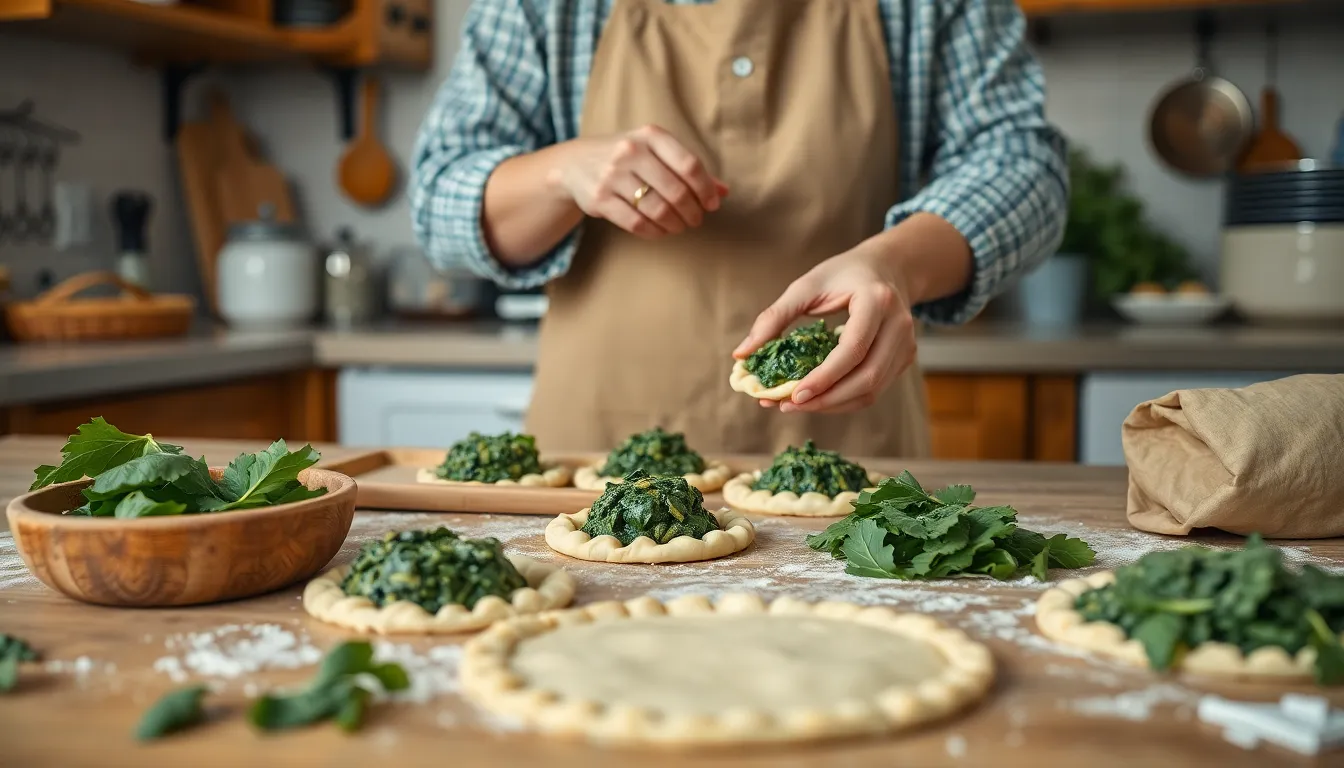
Arabic spinach pies are perfect for meal prep and can be prepared in advance through several methods to fit your schedule. Prepare the dough up to 24 hours before assembly by wrapping it tightly in plastic wrap and refrigerating; just bring it to room temperature for 30 minutes before rolling. The spinach filling can be made 1-2 days ahead and stored in an airtight container in the refrigerator—just drain any excess liquid before using.
You can assemble the unbaked pies completely and refrigerate them for up to 8 hours before baking. Simply place them on a parchment-lined baking sheet covered loosely with plastic wrap. For longer storage prepare the pies through the shaping stage then freeze them on a baking sheet until solid. Transfer the frozen unbaked pies to freezer bags where they’ll keep for up to 1 month. Bake directly from frozen adding an extra 5-7 minutes to the baking time.
Fully baked spinach pies freeze beautifully for up to 3 months. Cool them completely then arrange in a single layer in freezer-safe containers with parchment paper between layers. Reheat frozen baked pies in a 350°F oven for 10-15 minutes until heated through and crisp.
For best results when working ahead add a light egg wash to unbaked pies just before baking rather than during prep to prevent the dough from becoming soggy. The make-ahead flexibility of these spinach fatayer makes them ideal for entertaining or busy weeknight meal planning.
The Cultural Significance Of Arabic Spinach Pie

Arabic spinach pie holds profound cultural significance across the Middle East where it serves as more than just a delicious pastry. Throughout generations these triangular treats have been central to family gatherings symbolizing hospitality generosity and community bonds. During Ramadan fatayer bi sabanekh frequently appears on iftar tables when families break their daily fast offering a nutritious yet satisfying option that reflects traditional values.
In Levantine culture particularly in Lebanon Syria and Palestine these spinach pies represent culinary heritage passed down through generations. Women traditionally gather to prepare large batches of fatayer creating a social environment where cooking techniques family stories and cultural wisdom are exchanged. This collaborative cooking process strengthens intergenerational bonds and preserves culinary traditions that might otherwise be lost.
Religious celebrations and holidays showcase the importance of spinach fatayer as both a practical and symbolic food. Their triangular shape has been interpreted by some to represent the holy trinity in Christian communities while others view it as a symbol of prosperity. During Easter celebrations in Middle Eastern Christian communities these pies often feature prominently alongside other traditional dishes marking the end of Lenten fasting periods.
Beyond religious contexts spinach pies reflect the agricultural rhythms of the Mediterranean region. Seasonal availability of fresh spinach dictated when these pies would be made connecting families to local farming cycles and sustainable food practices long before these concepts became trendy. The inclusion of sumac olive oil and other indigenous ingredients further ties this dish to the land and regional identity.
The economics of fatayer also highlight its cultural importance as a practical solution for feeding families economically. During times of hardship these pies provided an affordable yet nutritious meal that could stretch limited resources. Their portability made them ideal for farmers and laborers who needed sustaining food while working long hours in fields or construction sites.
Modern Arab diaspora communities worldwide maintain connections to their heritage by continuing to make these beloved pies. Cultural festivals Middle Eastern restaurants and home kitchens in cities from Detroit to Sydney feature spinach fatayer as a tangible link to ancestral homelands. Through this simple yet beloved food cultural identity remains intact even thousands of miles from the Middle East.
Conclusion
Arabic spinach pies represent the perfect fusion of simplicity and flavor that’s stood the test of time. These triangle-shaped treasures offer both versatility and nutrition while connecting you to centuries of Middle Eastern culinary tradition.
You’ll find the process of creating these fatayer deeply satisfying as you master the distinctive folding technique and balance of flavors. Whether served as part of a mezze spread or enjoyed on their own these hand-held delights adapt to any occasion.
The make-ahead potential makes them practical for modern lifestyles while their cultural significance adds depth to your dining experience. Give this recipe a try and you’ll discover why generations of families have gathered around tables to enjoy these beloved spinach-filled pastries.
Frequently Asked Questions
What are Arabic spinach pies (fatayer bi sabanekh)?
Arabic spinach pies are triangle-shaped pastries featuring a tender, slightly chewy dough filled with seasoned spinach, sumac, onions, and spices. Unlike Greek spanakopita which uses phyllo dough, these pies have a thicker yeasted dough. They’re popular throughout the Middle East as appetizers, snacks, or part of mezze spreads, with each region having its own variation.
How do I prevent my spinach pies from becoming soggy?
Thoroughly drain your spinach before using it in the filling. Excess moisture is the main culprit for soggy pies. You can squeeze the spinach in a clean kitchen towel or press it in a colander. Also, avoid overfilling the pies and ensure they’re properly sealed before baking. Baking at the correct temperature (around 375°F) helps create a barrier that keeps moisture contained.
Can I make Arabic spinach pies ahead of time?
Yes! The dough can be prepared up to 24 hours in advance and refrigerated. The spinach filling can be made 1-2 days ahead. Unbaked assembled pies can be refrigerated for up to 8 hours or frozen for up to a month. Fully baked pies freeze well for up to three months. This flexibility makes them perfect for entertaining or meal prep.
What’s the best way to reheat leftover spinach pies?
For refrigerated pies, reheat in a 350°F oven for 7-10 minutes until warmed through. Frozen pies can be baked directly from the freezer at 350°F for 15-20 minutes. Avoid microwaving if possible, as it can make the dough soggy. Interestingly, many people find the flavor improves overnight, making leftovers especially delicious.
How do I properly fold the triangular shape?
Start with a circle of dough about 4-5 inches in diameter. Place a small amount of filling in the center, being careful not to overfill. Bring up three edges to form a triangle, pinching the seams firmly together. Ensure there are no gaps or holes where filling can escape during baking. The triangle shape helps lock in flavors and creates an attractive presentation.
Can I add other ingredients to the spinach filling?
Absolutely! Common additions include feta or mozzarella cheese, pine nuts, or walnuts for texture. Some versions incorporate ground meat for a heartier filling. You can substitute other greens like Swiss chard or kale for spinach. Pomegranate molasses adds sweetness, while adjusting spices creates regional variations. These customizations make the recipe versatile and adaptable.
What should I serve with Arabic spinach pies?
Serve with yogurt dip or labneh for dipping. They pair wonderfully with other mezze items like hummus, tabbouleh, and olives for a complete spread. For a more substantial meal, serve alongside lentil soup or a Mediterranean salad. Traditional beverage pairings include mint tea, Turkish coffee, or ayran (yogurt drink). They’re delicious warm, at room temperature, or even cold.
What is the cultural significance of fatayer bi sabanekh?
These spinach pies play an important role in Middle Eastern family gatherings and community bonds. They’re often featured during Ramadan and symbolize hospitality and generosity. In Levantine culture, making fatayer is a social activity that preserves culinary heritage. For Arab diaspora communities worldwide, these pies provide a tangible connection to cultural identity and traditions that transcend borders.
